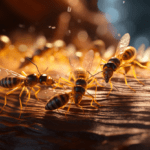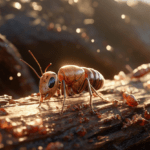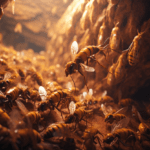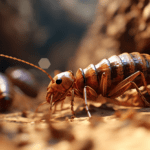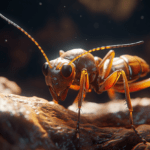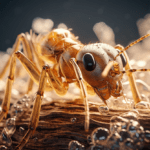When it comes to pest infestations, termites often top the list of homeowners’ nightmares. These tiny creatures are capable of causing extensive damage to homes and buildings, making it crucial for us to understand their lifecycle and feeding habits. In this article, we will delve into the world of termites, exploring the various stages of their lifecycle and shedding light on their typical feeding behavior.
Note: Curious about the frequency of termite feeding? Dive deeper into our previous article on How often do termites eat? for more insights.
1. Termite Life Cycle Overview
The life cycle of a termite is a remarkable journey that begins from a humble egg and culminates in the establishment of a full-fledged colony. Understanding this lifecycle is essential for implementing effective pest control measures. Let’s take a closer look at each stage.
2. The Beginning: Eggs And Hatching
The first stage of a termite’s life cycle starts with the laying of eggs by the queen. These eggs are usually white and about the size of a pinhead. Once laid, they are carefully tended by the worker termites, ensuring favorable conditions for development. After a few weeks, these eggs hatch into tiny, translucent larvae, marking the beginning of the termite’s journey.
3. Stage One: Larvae And Molting
During this stage, the newly-hatched larvae undergo a series of molts in order to grow. Molting is a fascinating process where the termite sheds its exoskeleton to accommodate its increasing size. The discarded exoskeletons, known as exuviae, can often be found around termite nests. This stage plays a crucial role in the development and transformation of the termite.
4. Stage Two: Nymphs And Development
As the larvae continue to molt, they progress into the nymph stage. Nymphs are similar in appearance to adult termites, but they are smaller and lack reproductive capabilities. They continue to molt and grow, gradually assuming the appearance and responsibilities of worker, soldier, or reproductive termites based on the needs of the colony.
5. Reproduction And Swarming
Once a termite reaches maturity, it may take on the reproductive role within the colony. Reproductive termites are responsible for the continuation of the termite population through swarming. Swarming occurs when reproductive termites leave the nest in large numbers, seeking mates and establishing new colonies. This spectacular event often takes place during spring when conditions are favorable.
6. Queen And Colony Establishment
During swarming, male and female reproductive termites pair up and shed their wings before finding a suitable location to start a new colony. The female termite, now known as the queen, establishes an underground chamber where she lays eggs and begins to reproduce. The queen’s primary responsibility is to ensure the survival and growth of the colony by constantly laying eggs.
7. Typical Feeding Habits of Termites
Termites are notoriously known for their voracious appetite and destructive feeding habits. These tiny creatures have evolved to feed on cellulose-containing materials, such as wood and plant fibers. They possess specialized enzymes and gut bacteria that allow them to break down cellulose, deriving nourishment from it. Unfortunately, this feeding behavior often leads to severe damage to homes and structures.
8. Termite Reproduction
Reproduction is a crucial aspect of the termite life cycle. Reproductive termites are essential for the survival of the colony, as they continue the generational cycle. Their ability to swarm and establish new colonies ensures the perpetuation of the species. Understanding their reproductive behavior can aid in implementing effective pest control measures and protecting our homes from infestations.
9. Termite Life Cycle
The termite life cycle is a fascinating process that encompasses the stages of eggs, hatching, larvae, molting, nymphs, and reproductive termites. Each stage contributes to the overall survival and growth of the colony. By understanding the intricacies of this lifecycle, we can better comprehend the behavior and habits of termites, enabling us to prevent and control infestations effectively.
THE LIFE CYCLE OF THE TERMITE
[youtube v=”JQynXLRfquA”]
The termite lifecycle begins with a mating flight, where reproductive males and females leave established colonies to procreate. After fertilization, they land and shed their wings to form new colonies. The king and queen termites are responsible for reproduction and determining the specialization of their offspring.
The king’s main job is to mate with the queen and release pheromones that control the development of workers, soldiers, and reproductives. Within five years, a king and queen can grow the colony to a million termites. The queen’s sole responsibility is to lay eggs and secrete pheromones that control specialization. She can live for over 25 years and lay more than 2000 eggs per day.
Once the fertilized queen lays her eggs, they hatch into pale white larvae. The larvae are fed by the king’s salivary glands and later by mature worker termites based on chemical messages from the queen and king. The larvae will develop into workers, soldiers, or primary or secondary reproductives over several molts. This stage takes about 30 days.
Nymphs are an intermediate stage that care for the larvae, king, and queen while waiting to become reproductive termites. They shed their exoskeletons through molting until they mature.
Workers are responsible for foraging for food, feeding the queen, king, soldiers, and caring for the larvae. Soldiers, with their oversized mandibles, emit a glue-like substance to immobilize invaders. Winged reproductives are thousands of mature nymphs who develop wings and wait for swarming season. They fly away from the colony towards light sources to mate and start new colonies.
In the rare instance when two winged reproductives in the group of elates come together, they may become a king and queen, giving birth to a new colony.
Overall, the lifecycle of the termite involves mating flights, the role of the king and queen in reproduction, the hatching of eggs into larvae, the development of different castes (workers, soldiers, and reproductives), and the creation of new colonies.
Conclusion
Termites, with their complex life cycle and destructive feeding habits, pose a significant threat to our homes and structures. By gaining knowledge and understanding the key aspects of their lifecycle and feeding behavior, we can take proactive measures to protect our properties. Regular inspections, timely pest control measures, and a vigilant eye for any signs of infestation can help us ward off these silent intruders and preserve the integrity of our homes.
- China II Review: Delicious Food & Speedy Service - April 17, 2025
- Understand Virginia’s Flag: History & Debate - April 17, 2025
- Explore Long Island’s Map: Unique Regions & Insights - April 17, 2025

